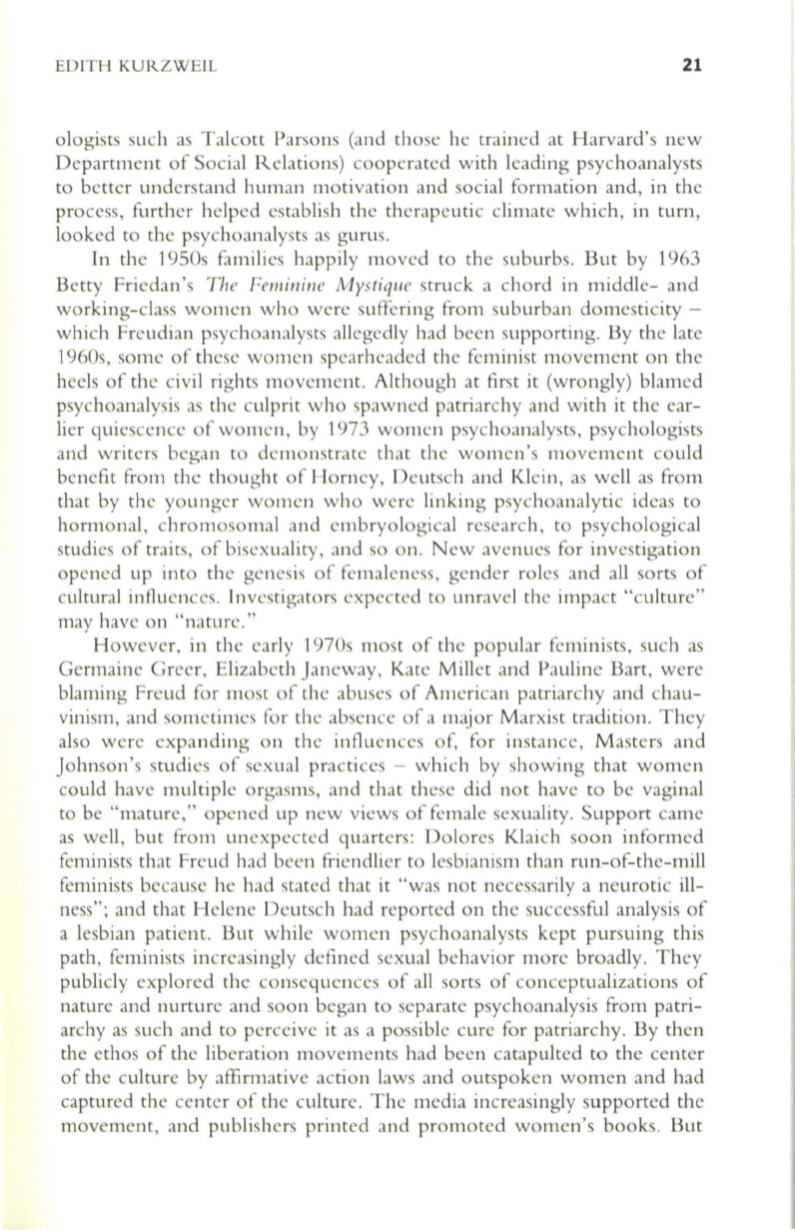
EDITH KURZWEIL
21
ologists such as Talcott Parsons (and those he trained at Harvard's new
Department of Social Relations) cooperated with leading psychoanalysts
to
better understand human motivation and social formation and, in the
process, further helped establish the therapeutic climate which, in turn,
looked to the psychoanalysts as gurus.
In the 1950s families happily moved to the suburbs. But by 1963
Betty Friedan's
The Feminine Mystique
struck a chord in middle- and
working-class women who were suffering from suburban domesticity -
which Freudian psychoanalysts allegedly had been supporting. By the late
1960s, some of these women spearheaded the feminist movement on the
heels of the civil rights movement. Although at first it (wrongly) blamed
psychoanalysis as the culprit who spawned patriarchy and with it the ear–
lier quiescence of women, by 1973 women psychoanalysts, psychologists
and writers began to demonstrate that the women's movement could
benefit from the thought of Horney, Deutsch and Klein, as well as from
that by the younger women who were linking psychoanalytic ideas to
hormonal, chromosomal and embryological research, to psychological
studies of traits, of bisexuality, and so on. New avenues for investigation
opened up into the genesis of femaleness, gender roles and all sorts of
cultural influences. Investigators expected to unravel the impact "culture"
may have on "nature."
However, in the early 1970s most of the popular feminists, such as
Germaine Greer, Elizabeth Janeway, Kate Millet and Pauline Bart, were
blaming Freud for most of the abuses of American patriarchy and chau–
vinism, and sometimes for the absence of a major Marxist tradition. They
also were expanding on the influences of, for instance, Masters and
Johnson's studies of sexual practices - which by showing that women
could have multiple orgasms, and that these did not have to be vaginal
to be "mature," opened up new views of female sexuality. Support came
as well, but from unexpected quarters: Dolores Klaich soon informed
feminists that Freud had been friendlier
to
lesbianism than run-of-the-mill
feminists because he had stated that it "was not necessarily a neurotic ill–
ness"; and that Helene Deutsch had reported on the successful analysis of
a lesbian patient. But while women psychoanalysts kept pursuing this
path, feminists increasingly defined sexual behavior more broadly. They
publicly explored the consequences of all sorts of conceptualizations of
nature and nurture and soon began to separate psychoanalysis from patri–
archy as such and to perceive it as a possible cure for patriarchy. By then
the ethos of the liberation movements had been catapulted to the center
of the culture by affirmative action laws and outspoken women and had
captured the center of the culture. The media increasingly supported the
movement, and publishers printed and promoted women's books. But


